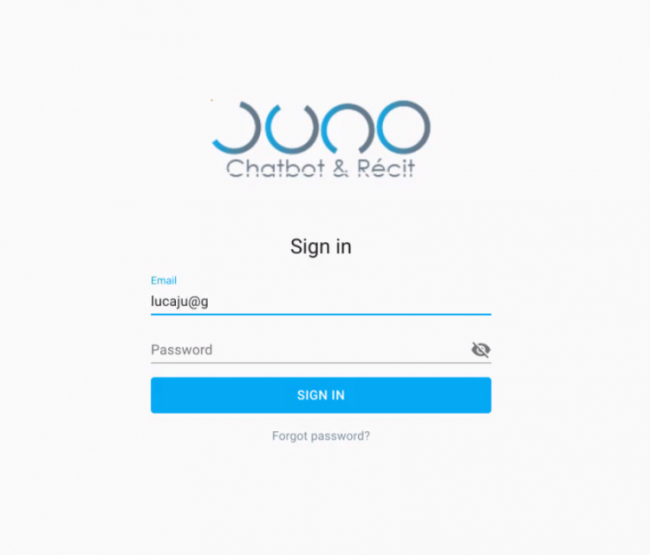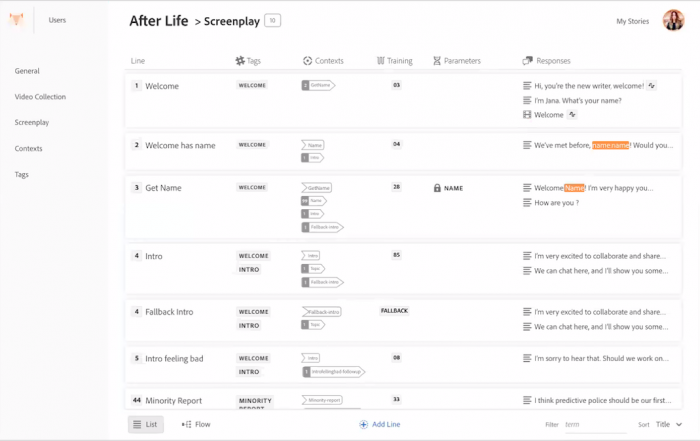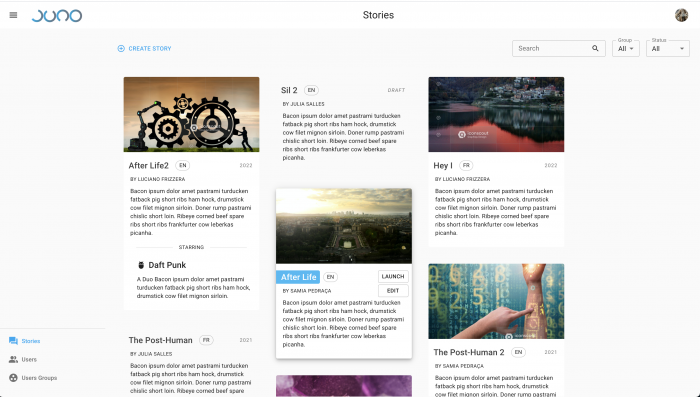by Julia Salles and Myriam Rafla
Designing Conversational Audiovisual Narratives Using Chatbot
Introduction
Young audiences today use many different forms of messaging as a means of communication. Advertisers and marketing gurus have come to understand the value of the chatbot as new ways of appealing to a young demographic and potential consumers. Research evidence shows that teenagers read a lot more if the text is presented in the form of text-message or instant messaging conversations (Gupta, 2017). Yet, understanding how online platforms facilitate exchanges with chatbots and the role that artificial intelligence (AI) plays in many of these systems, remains an enigma to the vast majority of users of such new technologies and platforms. This article focuses on the educational and research activities we are currently developing and demonstrates how chatbot storytelling can be applied in the classroom.
New technologies and digital platforms are engendering user interaction in audiovisual narratives, and chat fiction is one of these new forms of storytelling. One example is the Project Caretas, created by Unicef Brazil and Talk2U, that successfully reached a large audience of teenagers in a digital citizenship campaigning using chatbot for audiovisual storytelling. Caretas is a fictional experience on Facebook Messenger where the audience engages with Fabi, a chatbot that shares a series of audiovisual materials in a story about non-consensual image sharing (García-Montes, 2018).
Opening up to a dialogical approach to storytelling and education implies mobilizing participatory methods in research and in the development of the pedagogical tools. This dialogical turn that we notice in storytelling is also present in different fields of communication, as Davies notes: “over the last two decades there has been a shift from so-called deficit model understandings of science communication and policy to more dialogic, participatory approaches” (Davies, 2013). We will address how an interactive chat-based storytelling format can be mobilized to explore methods for teaching young audiences about online chatbot technologies. Our premise is that in order to be able to participate in the public debate and in the decision-making process for artificial intelligence’s use in communication technologies, young people should have a clear understanding of how AI is mobilized and operates.

Juno, An Interactive Storytelling Platform
Juno, An Interactive Storytelling Platform
Juno, An Interactive Storytelling Platform invites post-secondary students to collaborate in a participatory research project that aims to make the process of interaction with artificial intelligent systems more transparent for the users. The project’s main goal is to vulgarize concepts of artificial intelligence (AI) through practical applications, giving the student the opportunity to better understand concepts of natural language processing (NLP), machine learning (ML) and broader concepts of AI, as they build and design interactive conversational narratives with chatbots.
How can interactive storytelling help young students learn about artificial intelligence and natural language processing? The chatbot character is part of an emerging storytelling format where users navigate intersecting plot lines, theme driven subjects and engage in a dialogical and performative experience. We believe that the creation of stories that integrate chatbots and audiovisuals coupled with the understanding, creative and innovative use of AI, will encourage a more mindful and responsive engagement.

Juno, An Interactive Storytelling Platform
A Participatory Research Project
Through the process of designing a conversational narrative using chatbot technology, from the ground up, students will gain insight and a better understanding of how artificial intelligence makes prediction-based decisioning from its interactions with humans. Questions such as: How is natural language processing a result of human-machine interaction? How do artificial intelligent systems solve problems and make inferences? What is machine learning? What is data? What tasks and steps do algorithms perform to determine the outcome of data analysis? Are algorithms the result of machine learning processes? If so, what can an algorithm teach us about how machines ‘learn’ and how they manipulate data? With Juno, students will design interactive media by integrating conversational narratives and audio-visual media in a storytelling format. They will explore themes and concepts that they can implement in the conversational narratives they design.
Participatory research methods motivate students to take action and engage in collaborative processes of investigation, critical and practical analysis, and reflection. It gives the research participants the opportunity to define the research methods that they feel will help them best respond to their material and environment. With the guidance of their instructors, students will design documentation methods, including reports, surveys and data collection during the course of this study. Juno is aimed at post-secondary students in media studies, but it can be adapted to pedagogies in other disciplines as well.
We are currently developing two types of curriculum as follows:
Type 1: Training modules and participatory research in the classroom: For educational activities in the context of a regular course, the group of participants is made up of students from partner CEGEPs (Dawson and Cégep Saint-Laurent) enrolled in regular courses offered by teachers who have agreed to participate in the project.
Type 2: Dissemination workshops: For educational and professional activities, in areas of Social Sciences, Fine Arts and Pure and Applied Sciences.

Juno, An Interactive Storytelling Platform
Conclusion
By simulating dialogue interaction and creating stories based on ‘real-life’ exchanges, students will become more sensitized to the basic principles and processes of artificial intelligence. Juno offers students a participatory and self-reflexive experience through the application of innovative methodologies in education and research approaches. Furthermore, the exercise itself serves as a tool to explore ideas and subject matters of interest to the student. As chatbots mature, and as Juno evolves as a pedagogical tool, the ethical consideration involved in writing chatbot characters will become increasingly critical as the technologies and the possibilities they afford, also evolve.
Juno, An Interactive Storytelling Platform using Chatbots and audiovisual materials, is being developed in the framework of a trans-disciplinary collaborative research-development project led by Professor Francisco A. Loiola at l’Université de Montréal in collaboration with Concordia University, Dawson College and Cégep de Saint-Laurent in Montreal, Quebec, Canada. The research has been funded by the Ministère de l’Économie et de l'Innovation du Quebec (Quebec Ministry of Economy and Innovation). Researchers include: Maria Grullon, Phd candidate, Université de Montréal; François Haurat, PhD, Université de Montréal; Sirleia Rosa, Cégep de Saint-Laurent; Pier-Marc Gosselin, Professeur, Cégep de Saint-Laurent; en communication, Julia Salles, professionnelle de recherche et Chargée de cours de l’Université de Montréal; Myriam Rafla, Professor, Cégep Dawson; Luciano Frizzera, Phd candidate, Université Concordia; Sâmia Pedraça, PhD candidate, Université Concordia et Professeur Martin Gibert, Université de Montréal; Valéry Psyché, Professeur, TÉLUQ. The project enters its third phase of development when the platform is introduced in the classroom in the Fall 2021 semester at Dawson College and Cegep St-Laurent.
References
Davies, S. R. (2013). The rules of engagement: Power and interaction in dialogue events. Public Understanding of Science (Bristol, England), 22(1), 65-79. https://doi.org/10.1177/0963662511399685
García-Montes, M. (2018). AI storytelling on Messenger for youth citizenship. Creating Technology for Social Change. https://civic.mit.edu/index.html%3Fp=2226.html
Gupta, P. (2017, 20/8/2020). How We Got 10 Million Teens to Read Fiction on Their Phones. https://medium.com/@prernagupta/how-we-got-10-million-teens-to-read-fiction-on-their-phones-19a2a475084c
Author Biographies
Julia Salles is an audiovisual and new media researcher, creator and curator. She is a lecturer in Communication studies at Université de Montréal and a PhD candidate at Université du Québec à Montréal. Her research-creation interests focus on information and communication technologies, and she is currently exploring the use of artificial intelligence technologies in interactive documentaries and curatorial aspects of virtual reality. She is also a member of the Clermont-Ferrand International Short Film Festival programming committee. Julia works and lives in Montreal (Quebec) Canada.
juliacsalles@yahoo.com.br
Myriam Rafla is a fulltime faculty member of the Department of Cinema-Communications and a Research Fellow in Artificial Intelligence at Dawson College. Her research interests are in visual narratology, cultural memory and film studies. Myriam obtained an MFA from York University in Film Production with a specialization in Scriptwriting and launched her career in Québec cinema as a content analyst at Téléfilm Canada. As a member of the CNCT (Conseil nationale du cinéma et de la production télévisuelle) she was involved in film policy revisions and in implementing the new gender parity policy at SODEC. Myriam is a PhD candidate in Communication Studies at Concordia University. She lives in Montreal (Quebec) Canada.
myriam.ammar.rafla@gmail.com